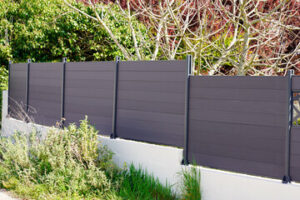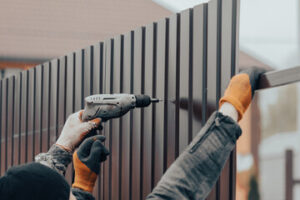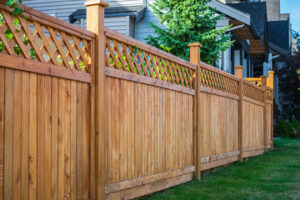Fence Companies Anchorage AK are businesses that specialize in constructing and installing fencing. They also repair existing fences. These contractors have the knowledge and experience to make sure that your new fence is installed correctly, taking into account soil conditions and other factors.

Fence offers property enclosure solutions to customers in the metro area. Its builders construct chain link, wood, bufftech wood grain, and picket fences. They also perform pool enclosure installation and maintenance.
The materials used in fence construction are a vital component to its overall durability. Choosing high-quality materials like vinyl or aluminum can increase the lifespan of your fence, saving you time and money in the long run. Similarly, premium wood options like cedar or pressure-treated hem fir are more durable than lower-grade lumber from the local lumber yard. In addition, using high-quality materials for your fence can help to prevent unwanted encroachment from neighbors and other property owners.
A quality fence acts as a frontline defense against harsh weather conditions that can take a toll on subpar materials over time. High-quality fence companies will use materials that are specifically designed to withstand the elements, ensuring your fence is both strong and visually appealing for years to come.
One of the most common uses for fencing is to mark a property’s boundaries and ensure that no one attempts to encroach on the land. Having a quality fence made from sturdy materials is essential for preventing this issue, and many high-quality fences have advanced security features that act as a deterrent against potential intruders. For instance, metal fences often feature reinforced panels and anti-climb designs that can thwart any attempt at unauthorized entry into your property.
High-quality fences are also more attractive than their cheaper counterparts. They can match your home’s aesthetic, and they can be matched with other landscaping features, such as gardens or porches. This can make your home more attractive, and it can also increase its resale value down the line.
Choosing a fence material that matches your home’s exterior can also improve its curb appeal, which can be especially important in a residential neighborhood. Using a local fence company that is well-acquainted with the area and its climate can help you select the right type of fence for your home.
In addition to being a great choice for privacy, cedar is also known for its beautiful aesthetic and can be stained or painted to suit your taste. However, it does require regular upkeep, such as a penetrating sealant and occasional washes with water. Composite, on the other hand, is a popular alternative that blends reformed wood fibers with plastic compounds and polymers. While it doesn’t need a sealant, it can benefit from occasional washes with water and has a stronger resistance to bugs and rot than natural woods.
Variety of Options
When it comes to finding a fencing contractor, you want to ensure that they offer a variety of options to suit your needs. The best way to do this is by searching online for the top fencing companies in your area. This will allow you to see what each one has to offer and narrow down your choices. Once you have a few candidates, visit their websites to learn more about them and their services. Many will feature photo galleries that you can browse through to get an idea of the type of work they do.
When choosing a fencing company, it is important to know what their policies and procedures are for handling customer complaints. You should also look into their insurance coverage, which will protect you in case a worker is injured on the job site. Most reputable fence companies will carry general liability insurance as well as workers’ compensation coverage to protect themselves and their clients.
Another important factor to consider when choosing a fencing company is their track record and experience. Ask for references from past clients to gauge how satisfied they were with their experience. You should also check out the company’s website and social media profiles to find out more about their business. This will give you a better idea of the level of quality you can expect from them.
A leading fencing company will be able to provide a wide range of product and material options to suit your preferences. They will also have years of experience and expertise in their field. This will help you avoid hiring a novice that may make costly mistakes that will cost you in the long run.
A leading fence company will also have a wide range of financing options to choose from. They will be able to suggest preferred lenders who can help you finance your project without worrying about credit. They should also have a warranty on their products and installation services to give you peace of mind. In addition to this, they will have a knowledgeable customer service department that can answer any questions you might have.
Save Time and Money
One of the greatest benefits of using a fence company is that it can save you time and money. For example, fencing contractors can save you from the hassle of having to dig your own post holes and pour concrete for each fence posts. Furthermore, fence companies have the experience and know-how to construct quality fencing that will last for years. This can also help you avoid the expense of costly mistakes such as improper installation, which may lead to structural problems and a fence that doesn’t meet building codes.
If you’re thinking of starting a fence company, you should research your local laws and regulations. You’ll likely need to register your business and obtain a license in order to operate. This may vary depending on where you live and the type of fencing company you plan to open. Additionally, you should consider your business structure and whether or not you want to employ staff.
Once you’ve established your business, it’s important to find clients. You can start by advertising your services online and in local newspapers. You can also use telemarketing to reach potential customers. Another way to attract customers is by offering discounts for fence maintenance or repairs. This will make your firm stand out from the competition and give your clients a reason to come back.
Fence companies can provide many other types of fencing products, including chain-link, wood, PVC vinyl, and custom steel supplies. They can also build ornamental, estate, or security fences. They can help you choose the best materials for your project and can install them with precision. Fence installation is a great choice for homeowners who want to protect their property and enhance the curb appeal of their home.
Fence installation is a profitable business that can be conducted from home or an office. It’s a good idea to get started with a business plan, as it will help you identify your target market and figure out how to differentiate yourself from competitors. This will also be helpful when you’re seeking funding from investors. You should also check with your state’s small business department to find out what licensing requirements you’ll need to meet.
Increase Property Value
Many people choose to build fences to protect their children or pets, and they also believe that fencing increases their property value when it comes time to sell. However, this is not always the case, and a lot depends on the quality of the fence and the location of the property.
A professional fence company will use specialized equipment that is both safe and effective, which allows them to complete the job in significantly less time than it would take an amateur. This not only saves you money on labor, but it also ensures that the work is done properly and with minimal risks.
Additionally, a fence company will have a wide variety of materials available, making it easy to find the right style for your needs and preferences. You can also choose between different finishes, including wood, vinyl, aluminum, and wrought iron. Each material has its own advantages and disadvantages, so it is important to consider your needs and the climate in your area when choosing a fence.
Furthermore, a good fence company will offer first-class customer service throughout the process of installing your new fence. This includes handling all the necessary paperwork and inspections, as well as providing assistance long after the fence has been installed (maintenance, repairs, etc.). They will also stand behind their work with a solid warranty on workmanship and a manufacturer’s warranty on the material.
A well-maintained and aesthetically pleasing fence can add significant curb appeal to your home, increasing its value in the eyes of potential buyers. It can also help define your outdoor living space and provide a sense of privacy, security, and exclusivity. In addition, a fence can provide a subliminal promise of protection for young children and pets, which can be very appealing to families looking for a safe and comfortable place to raise their family. While a fence may not increase your property value dollar-for-dollar, it can still be an excellent investment that provides substantial benefits for your family. Especially in a competitive real estate market like New Jersey, it is essential to do everything you can to make your home stand out from the competition.


